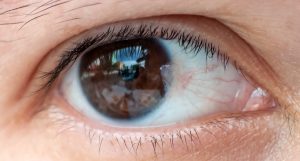What is a Pterygium?
Sometimes confused with a condition called pinguecula, a pterygium is a non-cancerous growth of the thin mucous membrane, or conjunctiva, which lines the ocular surface beyond the cornea. A pterygium appears as an elevated triangular thickening that is caused by excessive growth of the conjunctiva and extends on to the surface of the eye. Many  patients who develop this corneal condition work in outdoor environments in which they are exposed to sand, dust, wind, and sunlight. While the exact cause is still unknown, a pterygium, or surfer’s eye, is thought to be caused by exposure to UV rays and can be triggered or irritated in certain environmental conditions.
patients who develop this corneal condition work in outdoor environments in which they are exposed to sand, dust, wind, and sunlight. While the exact cause is still unknown, a pterygium, or surfer’s eye, is thought to be caused by exposure to UV rays and can be triggered or irritated in certain environmental conditions.
Treatment
You may not require treatment for the lesion if it does not cause any symptoms. However, when a pterygium does not respond to eye drops, or if it begins to cause vision problems that affect your daily activities, pterygium removal may be necessary.
Pterygium Surgery Process
Pterygium surgery requires that the lesion is removed from the surface of the eye. Then, a small piece of skin is taken from beneath the eyelid to fill in the area where the pterygium was removed. Using a self-transplant also helps in preventing the occurrence of pterygium. Surgery is usually performed as an outpatient procedure with topical and local anesthesia. Mild intravenous sedative medication may be given to keep the patient relaxed throughout the surgical process. The surgery typically ranges from 30-40 minutes for one eye. If there is a pterygium present on both eyes, the surgeries will be a few weeks apart to allow for the vision to be restored and healing to take place as well as lower the risks of an infection or complication.
Pterygium Surgery Recovery
After the procedure, the eye may be patched temporarily to minimize any residual bleeding. This patch will remain on the eye area until your one-day post-op. During the recovery period, patients may experience mild irritation, blurred vision, and redness around the eye. However, patients can return to normal activities, such as driving, work, and school, within the first few days. Full recovery can take several weeks to about a month. Patients are also instructed to use antibiotic and steroid drops for the first 1-2 months to prevent infection, reduce inflammation, and reduce the risk of occurrence.
Complications, such as infection, are rare but patients should be aware of the risk of recurrence. The risk of a recurring pterygium can be as high as 50% without the use of a conjunctival autograft or amniotic membrane. With the use of either tissue after pterygium excision, the risk is reduced to about 5-10%. Recurrent pterygiums are treated with similar surgical intervention.
Risks and Side Effects?
As with any surgical procedure, there is the potential for risks and complications.
Following the pterygium surgery, it is normal to experience some redness and discomfort and though it is rare, there is always the possibility of minor vision problems or reoccurrence later down the road. Pterygium surgery is often effective, but in mild cases, your doctor might recommend prescriptions and ointments to ensure an infection is not present.

 patients who develop this corneal condition work in outdoor environments in which they are exposed to sand, dust, wind, and sunlight. While the exact cause is still unknown, a pterygium, or surfer’s eye, is thought to be caused by exposure to UV rays and can be triggered or irritated in certain environmental conditions.
patients who develop this corneal condition work in outdoor environments in which they are exposed to sand, dust, wind, and sunlight. While the exact cause is still unknown, a pterygium, or surfer’s eye, is thought to be caused by exposure to UV rays and can be triggered or irritated in certain environmental conditions.